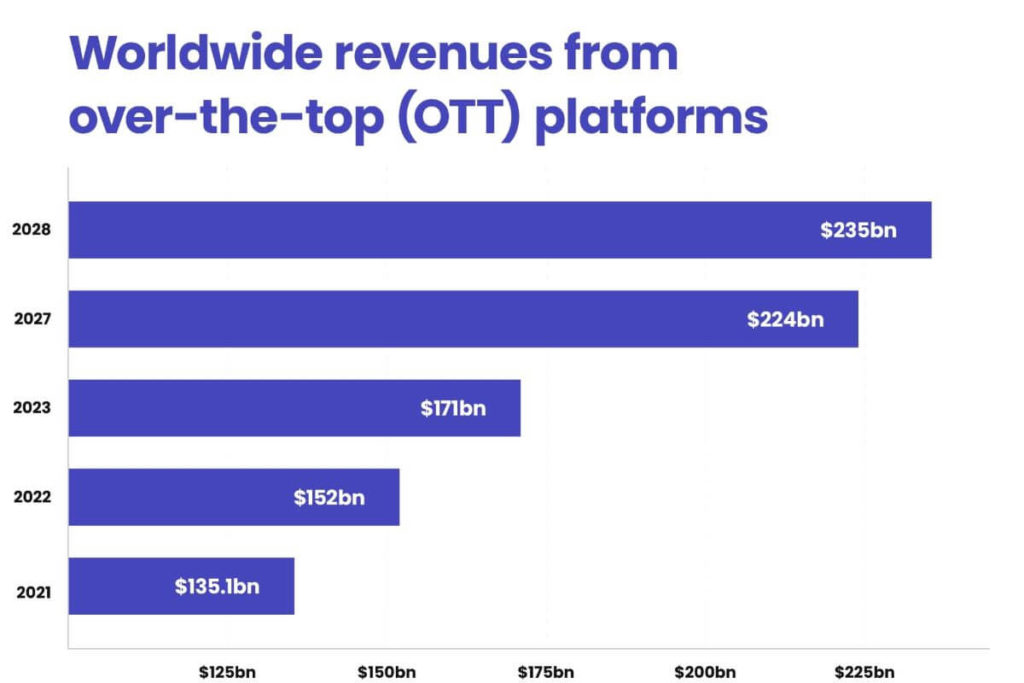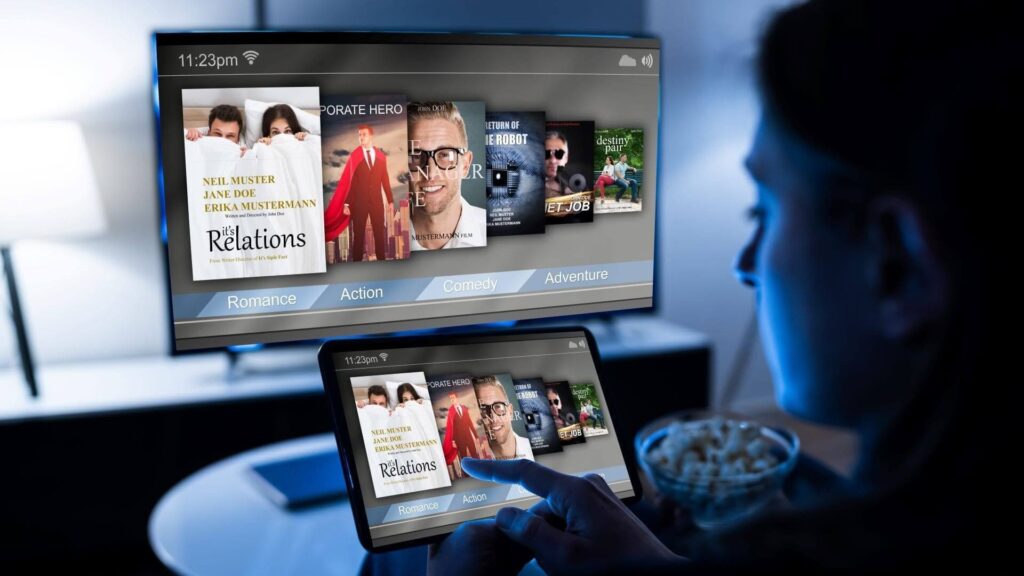The basics of OTT platforms – possibilities, obstacles and what’s to come
We’ve all witnessed the shift in content preferences of audiences over the years. Although still enormously popular, video formats have undergone many changes regarding their availability and the ways their content can be consumed. The biggest platforms such as YouTube, Netflix or HBO Max have become a staple in most households due to greater and easier internet accessibility. Now, thanks to the in-depth analysis of their viewers’ preferences and upgrades based on their behaviour, the companies can serve fully tailored experiences.
The platforms offer more than traditional TVs ever could and go beyond their limitations with materials that are accessible on demand from numerous devices. The boom of streaming services is deeply linked to the possibilities coming from the developments in the OTT world, and that is for good reasons. Let’s dive into the basics of OTT platforms and how they changed the world of content enjoyment.
What is OTT?
There has been a debate over the proper understanding of the term OTT. Depending on which part of the industry we asked – whether it’s OTT platforms owners, hardware manufacturers, operators or users, the answers can vary. Each group will have a slightly different definition based on their experiences and views of the solutions.
The acronym OTT which refers to “over the top”, has several meanings. Here are the ones that we believe are the most fitting.
- Most definitions rely on the principle that OTT could be described by any video streaming service that delivers content to users with the use of the internet. As the name suggests, at first, OTT was something that went beyond the service offered by traditional services like cable TV, hence over the top. An example of that is HBO Go, previously available in some countries as an addition for HBO cable subscribers.
- OTT can also describe a subscription model based on an agreement for additional fees. Then, when they are granted access, the user can freely utilise different materials. Sometimes, thanks to that option, users can skip other payments when opting for the solution that provides them with the free use of an internet connection (i.e., WhatsApp).
- While the main focus of OTT solutions is video, OTT audio services are also known to fit this description. Spotify is to music what Netflix is to TV – offering a massive material portfolio via the internet connection.
What are the OTT platforms?
Nowadays, it would be hard to even imagine life without streaming services. Their prominence has become an obvious part of discovering and accessing content. It’s no longer a novelty, but a much-needed part of the culture. It feels like new platforms are emerging each day, and it’s not a surprise with such an in-demand service. It may seem like the position of the biggest players is untouchable, but there is still plenty of room for improvement.
OTT platforms also enable access to live streaming. These work much like channels in regular TV, but the content is streamed using the internet connection to the audience’s OTT devices.
Possibilities of OTT platforms
The revenues speak for themselves. According to the report provided by Digital TV Research, over the top (OTT) media is said to reach $235 billion of revenue by 2028.

Source: Over-the-top (OTT) TV and video revenue worldwide
Notably, last year saw that the end of big-player market dominance is already happening. In the post-pandemic era and with market expansion, top brands are struggling to keep up their high revenues. Additionally, the audience expects and welcomes newcomers with fresh ideas and content in mind.
Monetising content on OTT platforms – Advertising
Where traditional TV struggled, OTT shines – precise ad targeting and distribution resolved the ongoing problem content providers previously faced. It was merely a prediction principle that was utilised. For example, around dinnertime, you play food commercials. The end result can be good or bad, but not entirely predictable, as you could not measure the effects and design campaigns accordingly for a specific demographic.
OTT platforms changed and revolutionised the game. The ads can be set to be displayed to specific viewers, segmented by age, gender, content preferences, geography and much more. Advertisers can multiply their reach for particular targets and calculate ROI more accurately.
Moreover, ads can also be input into subscription-based operations. The move towards the availability of partially ad-based subscription plans has been noticeable in the last year, with even Netflix joining for the ride. This opens ad display opportunities with new viewers that are tired of accumulating numerous platform fees.
OTT vs SVOD vs IPTV – what’s the difference?
With so many acronyms in use when talking about streaming, it is easy to get confused. The acronyms OTT, SVOD and IPTV are often misused, so here’s a quick guide to what they actually mean:
- IPTV is a TV service which delivers materials by the Internet Protocol, hence the IP in the name. The video stream is made available through a private network, and the users can gain access only via specific devices called set-top-boxes chosen by the current operator.
- VOD (video on demand) refers to a service that delivers materials after payment is issued, most often accounting for individual pieces of content.
- Subscription-based video on demand (SVOD) involves a monthly payment for access to content shared by the service provider, similar to traditional linear TV but with a different rule of operation. The content is available on demand, as the name suggests, and the use involves an internet connection. The perfect industry examples of such services are Sky (plus its subsidiary Now TV), Amazon Prime Video, Netflix, and Hulu.
Why are white-label OTT platforms the new go-to
Due to their rising popularity, we encounter white-label OTT solutions more often each day. Well, if you are wondering whether a white-label app is a good choice for your business development strategy, here are the main benefits in favour of this solution.
- White-label apps are a relatively cheap and low-risk way of testing the waters of adding a new platform to your offer or exploring a new branch of business.
- They are a chance to broaden your company’s client reach and market presence, especially when you want to present your service to a niche target group.
- These apps usually offer a good number of customisable options, suitable for someone who doesn’t need additional or complex functionalities.
- Their maintenance is not very costly and time-consuming as other popular options.
How to make white-label yours
Although it is a surprise to many people, it is possible to make white-label more personalised than it may seem at first glance. One of our teams focuses on the media and entertainment industry and offers a white-label platform with additional customisation. What does it mean for content providers? It means that the clients can easily add custom components of their needs to the platform, as a result going further than the basic pre-made options.
Moreover, although the same base is typically utilised, the owner can optimise the branding of each view of the platform with different devices in mind. They can look similar or drastically different. There are also plenty of components to choose from, so the options seem to be endless.
Emerging in a dynamic market
Some tend to believe that it’s impossible to make a mark in a somewhat saturated market. That is not entirely true. There have been some audience engagement drops among the biggest players, which at first may seem discouraging. However, if we look at it from the other angle, we can see a gap that can be filled when answering the customers’ demands. OTT platforms are not over but evolving, and if treated properly, the provided solution may even exceed expectations and set a new standard. How is this possible? In short, diligence, social listening and analysis, as well as proper development.
Use your knowledge
In the post-pandemic era, it may at times be difficult to grasp the reality of new and different ways of using and streaming content. The providers and media companies try to outdo themselves to gain audience engagement but often to no avail, offering more and greater experiences but still lacking the basics.
As OTT continues to develop, we can expect it to achieve even better results than before. That is, of course, if the solutions themselves are done well. The good news is that we can help with that.
If you are interested in OTT platforms or are considering launching one, get in touch with our media and entertainment team. We will happily set up a call to discuss your project and goals.
About the author
Our blog




